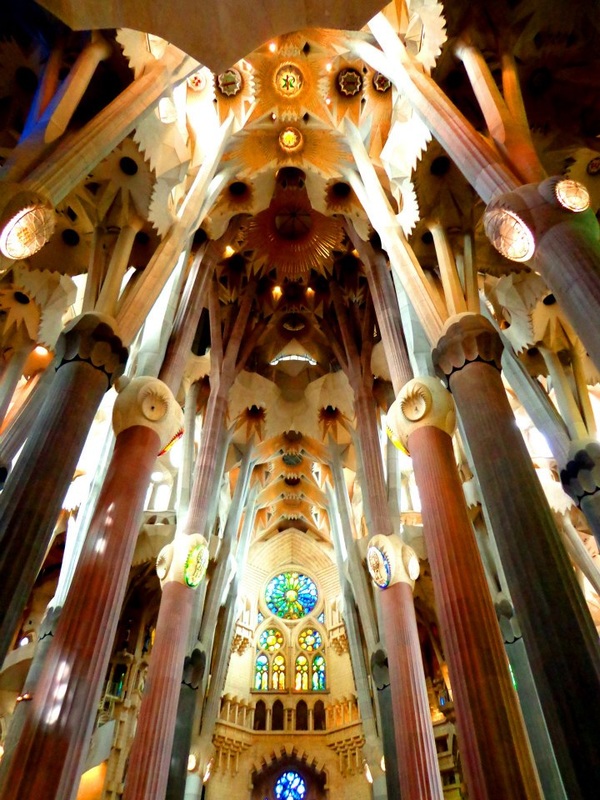|
Are you feeling the heat this summer?
Maybe you feel more relaxed, or maybe you feel uncomfortable with your sweat. The good news is that heating up your body can not only help to increase your flexibility in yoga poses, but it also typically leads to sweating, which helps your body to get rid of toxins faster. Experts agree that we mainly release excess salt, cholesterol and alcohol, which means that sweaty exercises will de-bloat us and clean our clogged arteries. Further, our sweat also works as an antibiotic. If our skin is wounded by a small cut, a scratch, or the sting of a mosquito, antibiotic agents secreted in sweat glands, such as dermcidin, rapidly and efficiently kill invaders. The heat also encourages an increase in cardiovascular activity and helps you burn more calories.
3 Comments
Interior of Sagrada Familia Have you ever felt inspired with a great idea? The practice of meditation, as a part of yoga, is a tool to help us quiet our mind and tap into to the deep places of our consciousness that inspire creative ideas to emerge. As described in the ancient Vedas and Upanishads of yoga philosophy, the universe expresses itself as spontaneous creative energy in the form of what we call Prana, the intelligent life force. When we practice awareness in asana (the physical postures), and pranayama (breathing techniques), we fuel the creative process by increasing and directing the flow of prana, through the energy channels in our body. Therefore, yoga allows us to open up to that passage, that connection with the divine. We are reminded of our conscious movement connections each time we flow through Sun Salutations: Inhale, reach your arms up to the sky. Exhale, swan dive and forward fold. Inhale, halfway lift and exhale fold with your chin to your chest. Inhale, step back into plank pose- one straight line with your body. Exhale, lower through Chaturanga.
I had the wonderful opportunity to write an original blog post for BeYogi.com. Check it out by clicking on the photo and or watch on YouTube. https://beyogi.com/yoga-divine-universe/ Does your mind often wander between memories, dreams, plans, and concerns?
Do you feel like your mind is constantly jumping from one thought to another, sometimes even skipping mid-thought through two other thoughts and then back again? Although this is typical behavior for our minds, we can learn to control it to find peace. In Pantajali’s Path to Enlightenment, Dharana, the 6th Petal, is the practice of concentration. In Light on Life, B.K.S. Iyengar teaches that our objective in Dharana is to achieve the mental state where the mind, intellect, and ego are all restrained and therefore offered to the Divine power. When we reach this state of immovable concentration of the mind, healing, grace, and peace can take place within us. What does freedom mean to you?
The literal meaning is the quality or state of being independent or freedom from control of another. Does this mean that we can behave in any way that we please? Some people believe that they have the "freedom to pollute" or "freedom to deforest." Because these activities create negative effects on everyone else through taking advantage of the environment, I agree with environmentalists who often argue that political freedoms should include some constraint on use of ecosystems. The popularity of SUVs, golf, and urban sprawl has been used as evidence that some ideas of freedom and ecological conservation can clash. Liberty, however, concerns the rights of all involved. This concept of political freedom is closely connected with the concepts of civil liberties and human rights. We should all have the freedom to pursue a healthy balanced life. The statue of liberty is our reminder to embrace freedom as a light, a source of goodness and wisdom to share with others. This goodness is shown through laws of human rights and equality. This statue is a welcoming sight to immigrants arriving from abroad. Officially titled, "The Statue of Liberty Enlightening the World" it is recognized as a universal symbol of freedom and democracy. Artist Bartholdi wished to give the statue a peaceful appearance and chose a torch, representing progress instead of revolution. The statue is of a robed female figure representing Libertas, the Roman goddess of freedom widely worshipped in ancient Rome, who bears a torch and a tabula ansata (a tablet evoking the law) upon which is inscribed the date of the American Declaration of Independence, July 4, 1776. A broken chain lies at her feet, representing our release from the rule of Britain. |
Hannah Faulkner
|























 RSS Feed
RSS Feed